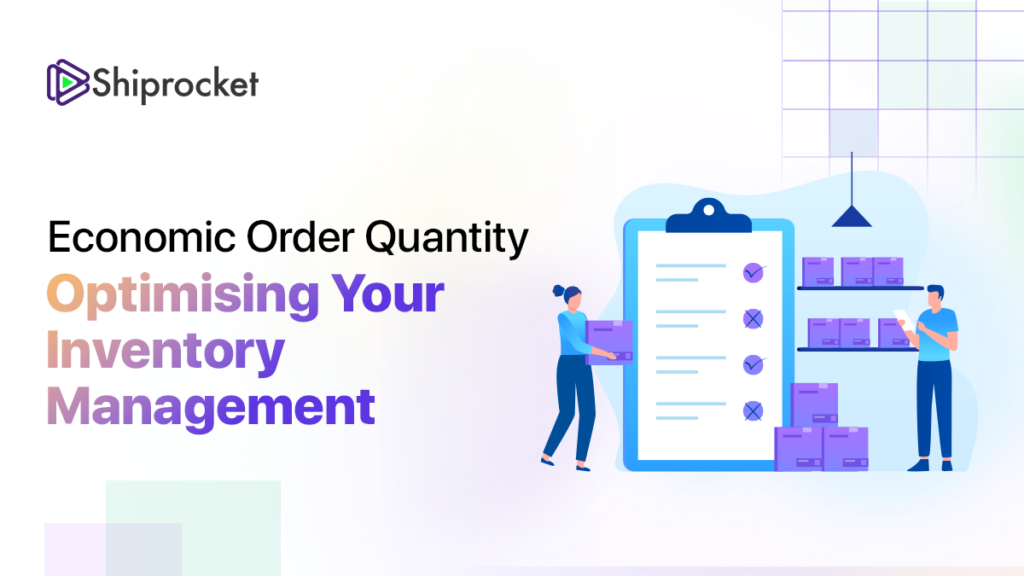Economic Order Quantity: Formula, Advantages, & Difficulties
EOQ or Economic Order Quantity is a critical calculation used by companies to minimise total costs when updating the inventory. The EOQ formula calculates the total cost of the inventory like the costs of holding, shortage, or order during the continuous review inventory system. In the EOQ model of inventory management when stock-in-hand reaches the ‘x’ level, ‘n’ units are reordered to maintain sustainability in order fullfilment.
Thus, EOQ is a powerful tool that helps businesses decide when to reorder, how much to order and how frequently to reorder, such that inventory management costs are at their lowest.
Here we explore how to use the EOQ formula with examples and understand the business implications and the challenges of optimising inventory management using EOQ equations.

Formula for EOQ
The EOQ formula is the ideal tool to determine stocking parameters such as frequency of reordering, units to be reordered and time to order. The components of the formula and an analysis of it are discussed in detail here.
In the EOQ model, a theoretical approach is used for the purchase of an ideal quantity of goods. Several factors are taken into consideration for this calculation. Demand and inventory depletion are assumed to be constant and at fixed rates until they reach zero. The number of units that need to be ordered to return the inventory to its starting level is calculated when the stock reaches zero. The model also assumes immediate replenishment of stock and does not factor in inventory shortages or the costs associated with it.
Thus, the cost of inventory using the EOQ model is limited to balancing the total holding cost versus the order cost. For example, when a company places a single order for a large number of units, the holding cost increases and the order cost decreases. Similarly, when fewer units are ordered, the holding costs decrease but the order costs go up. It is only with the EOQ model that a company is able to determine the point at which the optimised quantity will minimise the sum of the costs.
TC= PD+HQ/2+SD/Q
TC- annual inventory cost
P- price per unit
D- number of units ordered in a year
H- holding cost incurred per unit per year
Q- units purchased per order
S- cost of each order
In effect, the EOQ formula determines that an ideal order quantity is possible only when half of the products of the holding costs per unit and units per order equals the result of the quotation when the fixed price costs of each order and the number of units per year are divided by the per order units.
EOQ formula = Square root of 2DS/H.
Insights Gained from EOQ Analysis
EOQ analysis helps inventory managers to calculate the ideal order size. It is a quick and effective way to avoid stockouts, and reduce inventory and carrying costs. An EOQ analysis provides insights on:
- Holding costs: By reducing the carrying costs of holding inventory, organisations can measure their sustainability. The savings from using EOQ can be used for other business needs like R&D or marketing.
- Big Opportunity cost: Inventory is an asset and even a working capital to help businesses match regular operations. Thus, EOQ analysis helps companies to identify big opportunities where their inventory can be used as assets/investments.
- Impact on profits: Apart from the direct impact on managing inventory, it helps companies to make profits. Especially when making large, expensive and high-volume purchases, EOQ analysis helps businesses to streamline the process and thereby have better profits.
The primary insight from the EOQ formula is that businesses decide on how much they need to invest in maintaining their inventory. It helps in determining the ideal order size, minimises overspending on orders and lowers holding costs and excess inventory.
Economic Order Quantity Example
Explanation of the EOQ formula, with example, is the best way to understand the working of economic order quantity concept. The equation takes into account a number of factors such as the timing of your order, the cost to place the order, and merchandise storage. When a company is continuously ordering in small quantities such that the specific inventory level is maintained, there is a surge in ordering costs apart from additional storage space. By using economic order quantity calculations, businesses can find the best number of units to be ordered.
For example, a motorsports store selling ATVs and off-road vehicles for teens and adults sells 1000 units annually. The company incurs a cost of USD 1200 annually to hold its stock. The charge of placing an order is USD 720.
The EOQ formula = square root 2DS/H
That is the square root of (2 x 1000 units x 720 order cost)/(1200 holding cost) = 34.64.
Based on this result, 35 units is the optimal number of units the store needs to optimise inventory costs. For further reordering, the company needs to use the advanced version of the formula.
Business Implications of Economic Order Quantity (EOQ)
The EOQ model of inventory management creates opportunities for saving order costs, holding costs and upfront capital investments in buying stock.
- The EOQ formula helps businesses to consider an annual assessment of their inventory and order according to supply or demand. The premise of the formula is that the demand will be regular, constant or flat.
- Sometimes, businesses need to rethink the implications of EOQ, especially if they are small-sized organisations. For growing businesses, the formula approach may not be very satisfactory as the numbers would be changing frequently. But, using the formula as a thumb rule to determine the annual inventory needs in terms of units, and frequency of orders, will help in a big way to minimise inventory overheads.
- EOQ is also an effective way to include pricing discounts, defective items and backorders.
- EOQ helps to determine a predictive inventory schedule for businesses to have an optimised supply chain order plan in place.
Advantages of Economic Order Quantity (EOQ)
EOQ is an ideal tool for businesses that buy and hold inventory for manufacturing, resale and even for internal consumption of stock. It can help businesses to achieve efficiency in a number of ways. Some of them are:
- Optimise order fulfillment: Accurate calculations ensure you do not hold stock in excess. Businesses will be able to fulfill orders on demand with optimised EOQ and improve customer experience and sales.
- Prevent stockouts: EOQ formula and predictive forecasting ensure you do not run out of stock, even during peak season sales.
- Lower storage costs: By matching demand with order, the storage of products is also minimised. As a result, companies can save on real estate charges, security, utility costs and insurance.
- Reduce waste: With optimised order schedules you can cut back on obsolete inventory. It is the ideal solution for businesses dealing with perishables to handle dead stock.
- Improve profitability: The advantage of EOQ is that it works like a cash tool in the inventory management process and helps you lower storage costs.
However, EOQ relies on assumptions that may not always hold true in real-world scenarios. These are:
- Steady demand
- Immediate availability of items to be restocked
- Fixed costs of inventory units, ordering charges, and holding charges
The ideal situation for using EOQ is when consumer demand is constant for an extended period of time and inventory depletes at a fixed, consistent rate.
Difficulties in Implementing EOQ
Economic order quantity in inventory management is sometimes a challenge for businesses to adopt. Some of the difficulties when determining EOQ are:
- Non-availability of data: To determine EOQ, reliable and accurate data is necessary. If the business still deals with spreadsheets or a manual system, data may not be readily available and may be low-quality or outdated. This will result in inaccurate calculations of EOQ.
- Outdated Systems: Legacy infrastructure may have outdated systems/incomplete data, impacting lively savings.
- Business Growth: EOQ formulas help businesses to have a constant inventory flow. With businesses growing at a fast pace, EOQ could result in inventory shortages
Optimising Inventory Management with EOQ
It is possible to improve inventory management and optimise it by calculating EOQ and determining the ideal order size, maximising profits. It ensures that you do not guess and order, resulting in overstocking, overordering or understocking issues. Predictive ordering is very easily managed with EOQ equations, apart from helping businesses create a schedule to optimise their supply chain.
Conclusion
In many ways, the EOQ equation can be defined as the master key to control inventory costs and help businesses have a streamlined stockpile of their products. EOQ formula and analysis help businesses understand consumer demand and generate comprehensive supply chain optimisation options. Businesses can leverage formula-based accurate data prediction to control their inventory spending. More importantly, it calculates both ordering as well as holding costs and helps in incorporating the losses due to damages, defective inventory and more. Besides, EOQ also provides analytic viewpoints that guide businesses in addressing seasonal changes in inventory costs and account for losses in revenue.
Yes, EOQ calculations can be integrated into enterprise resource management software platforms for efficient management of inventory and minimise inventory management costs.
Yes, both the formulas determine different factors. EPQ finds the holding cost per year and is calculated to guide production levels. EOQ calculates the ideal order size to minimise business costs and guides inventory management.
Yes, EOQ and Wilson formulas define different factors. EOQ finds the best number of orders and units to be placed to save inventory costs. However, the Wilson formula finds the optimal quantity to order. It considers the administrative cost, discount offered for the size of the order against the cost of capital investment, and storage risk.





